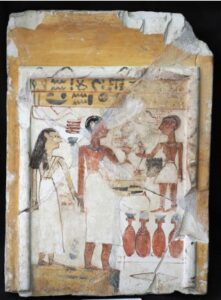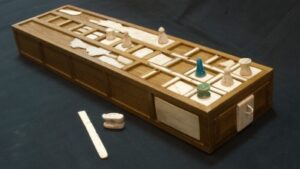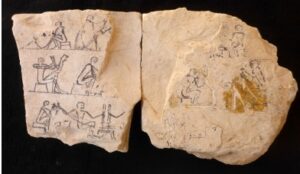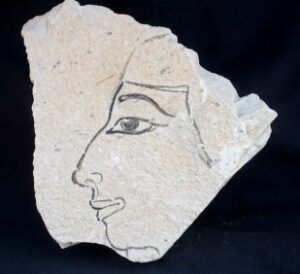A breath-taking collection of ancient artefacts is on display, for the first time, temporarily at the Luxor Museum of Ancient Egyptian Art.
The collection, unearthed by a joint Egyptian-Spanish archaeological mission in the necropolis of Dra’ Abu el-Naga’ on the West Bank of the Nile in Luxor, contains 140 pieces, including a coloured wooden coffin that dates back to the early 12th Dynasty (1991 BC – 1802 BC), a statement by the Ministry of Tourism and Antiquities said.
The same collection contains another wooden coffin with a cover decorated with feathers, a coffin containing the mummy of a 15-year-old girl who has a set of necklaces on her chest, rings and earrings and a coffin for a 5-year-old child that dates back to the 17th Dynasty (c. 1580 BC–c. 1550 BC).
The head of the Museums Sector at the Supreme Council of Antiquities, Moamen Othman, said exhibited along the aforementioned collection are also a group of clay ritual vessels, pottery vessels, archery, arrow tools, and three limestone panels that date back to the Second Intermediate Period (1782 BC – 1570 BC).
The same group, he added, consists of a linen cloth inscribed with red ink, which dates back to the 18th Dynasty (c. 1550 BC–1292 BC).
Director-General of Luxor Museum of Ancient Egyptian Art, Alaa el-Minshawy, said the artefacts on display at the museum also include a bronze statue of Osiris from the Ptolemaic era, a falcon mummy with a funerary mask made of cartonage, an ibis bird, and a mouse-like fly that dates back to the Ptolemaic era.
A number of golden earrings, part of a belt with shells made of gold, turquoise and agate, from the era of Queen Hatshepsut of the 18th Dynasty are also on display, he said.
Golden pendants that were used as a necklace, which is an amulet, dating back to the 28th Dynasty, and a necklace made of palm tree fibres belonging to the 17th Dynasty are also there, el-Minshawy added.
Meanwhile, Head of the Spanish Archaeological Mission, José Manuel Galán, said the exhibition includes sketches of decorative shapes for the wall of one of the tombs, dating back to the early 18th Dynasty.
He noted that pottery remnants that are part of a funeral procession and the ancient Egyptian board game (senet), dating back to the early 8th Dynasty (2181 BC– 2160 BC), are also exhibited.
Luxor Museum of Ancient Egyptian Art started exhibiting all these pieces on February 9, 2023. They will continue to be on display for the next six months.










Discussion about this post